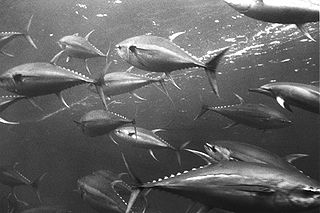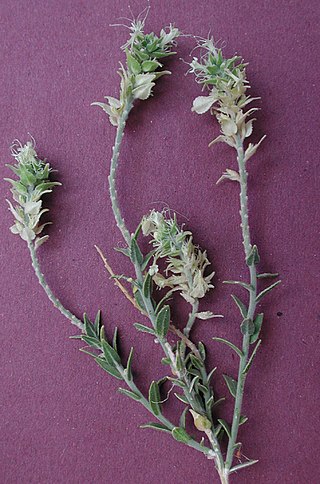
Chondrichthyes is a class of jawed fish that contains the cartilaginous fish or chondrichthyians, which all have skeletons primarily composed of cartilage. They can be contrasted with the Osteichthyes or bony fish, which have skeletons primarily composed of bone tissue. Chondrichthyes are aquatic vertebrates with paired fins, paired nares, placoid scales, conus arteriosus in the heart, and a lack of opecula and swim bladders. Within the infraphylum Gnathostomata, cartilaginous fishes are distinct from all other jawed vertebrates.

Cyprinidae is a family of freshwater fish commonly called the carp or minnow family, including the carps, the true minnows, and their relatives the barbs and barbels, among others. Cyprinidae is the largest and most diverse fish family, and the largest vertebrate animal family overall, with about 3,000 species; only 1,270 of these remain extant, divided into about 200 valid genera. Cyprinids range from about 12 mm in size to the 3 m (9.8 ft) giant barb. By genus and species count, the family makes up more than two-thirds of the ostariophysian order Cypriniformes. The family name is derived from the Greek word kyprînos.

The mackerel, tuna, and bonito family, Scombridae, includes many of the most important and familiar food fishes. The family consists of 51 species in 15 genera and two subfamilies. All species are in the subfamily Scombrinae, except the butterfly kingfish, which is the sole member of subfamily Gasterochismatinae.

Characidae, the characids or characins is a family of freshwater subtropical and tropical fish, belonging to the order Characiformes. The name "characins" is the historical one, but scientists today tend to prefer "characids" to reflect their status as a by and large monophyletic group at family rank. To arrive there, this family has undergone much systematic and taxonomic change. Among those fishes that remain in the Characidae for the time being are the tetras, comprising the very similar genera Hemigrammus and Hyphessobrycon, as well as a few related forms such as the cave and neon tetras. Fish of this family are important as food and also include popular aquarium fish species.

Sardine and pilchard are common names for various species of small, oily forage fish in the herring family Clupeidae. The term sardine was first used in English during the early 15th century; a somewhat dubious folk etymology says it comes from the Italian island of Sardinia, around which sardines were once supposedly abundant.

The Squaliformes are an order of sharks that includes about 126 species in seven families.

The ocean sunfish or common mola is one of the largest bony fish in the world. It was misidentified as the heaviest bony fish, which was actually a different species, Mola alexandrini. Adults typically weigh between 247 and 1,000 kg. The species is native to tropical and temperate waters around the world. It resembles a fish head without a tail, and its main body is flattened laterally. Sunfish can be as tall as they are long when their dorsal and ventral fins are extended.
Rockfish is a common term for several species of fish, referring to their tendency to hide among rocks.

The Cyclopteridae are a family of marine fishes, commonly known as lumpsuckers or lumpfish, in the order Scorpaeniformes. They are found in the cold waters of the Arctic, North Atlantic, and North Pacific oceans. The greatest number of species are found in the North Pacific. The family name Cyclopteridae derives from the Greek words κύκλος (kyklos), meaning "circle", and πτέρυξ (pteryx), meaning "wing" or "fin", in reference to the circle-shaped pectoral fins of most of the fish in this family.

Sand sharks, also known as sand tiger sharks, gray nurse sharks or ragged tooth sharks, are mackerel sharks of the family Odontaspididae. They are found worldwide in temperate and tropical waters. The three species are in two genera.

Ophichthidae is a family of fish in the order Anguilliformes, commonly known as the snake eels. The term "Ophichthidae" comes from Greek ophis ("serpent") and ichthys ("fish"). Snake eels are also burrowing eels. They are named for their physical appearance, as they have long, cylindrical, snake-like bodies. This family is found worldwide in tropical to warm temperate waters. They inhabit a wide range of habitats, from coastal shallows and even rivers, to depths below 800 m (2,600 ft). Most species are bottom dwellers, hiding in mud or sand to capture their prey of crustaceans and small fish, but some are pelagic.

Sander is a genus of predatory ray-finned fish in the family Percidae, which also includes the perches, ruffes, and darters. They are also known as "pike-perch" because of their resemblance to fish in the unrelated Esocidae (pike) family. They are the only genus in the monotypic tribe Luciopercini, which is one of two tribes in the subfamily Luciopercinae,

Acacia denticulosa, commonly known as sandpaper wattle, is a species of Acacia native to the south-west of Western Australia. A spindly shrub 1–4 m high, it flowers from September to October, producing dense, curved, yellow flower spikes.

Bathyraja is a large genus of skates in the family Arhynchobatidae.

Petalonyx is a small genus of flowering plants native to the southwestern United States and northern Mexico. They are known commonly as sandpaper plants, and are most often found in warm, dry desert regions. Sandpaper plants are subshrubs that get their common name from their rough foliage, which is covered in tiny, stiffly curved hairs. They bear racemes of claw-shaped flowers with long stamens extending well beyond the corolla, and unusual in that they emerge from outside the corolla.

Tetractenos is a genus of Tetraodontidae. The genus can be found throughout the Indo-West Pacific and Australia's southern and eastern coastlines.
The sandpaper figs are so named for their leaves, which are rough and sandpaper-like in texture. The common name may refer to a number of species in the genus Ficus:
The visitor, also known as the sandpaper velvetfish,is a species of marine ray-finned fish, a velvetfish belonging to the family Aploactinidae. It is the only member of the monotypic genus Adventor. This species is found the Pacific Ocean waters along the coasts of Papua New Guinea and Australia.
Paratrachichthys fernandezianus, the Chilean sandpaper fish, is a member of the family Trachichthyidae. It is native to the Desventuradas Islands and the Juan Fernández Islands off the coast of Chile. Despite its relatively limited range, it is listed as least concern by the IUCN because its population is not threatened at present. The Juan Fernández Islands are a marine reserve and the Desventuradas Islands are mostly uninhabited. It can be found between 0m and 20m from the surface of the ocean, also known as the photic zone.

Platyplectrum is a genus of ground-dwelling frog in the family Limnodynastidae. Species in this genus are found in Australia, New Guinea, and on the Aru Islands. They are medium-sized frogs and the dorsal skin has a sandpaper-like texture.
















